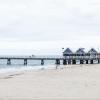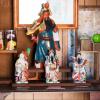Unexpected gems


Many of the objects in museum collections are extraordinary – not just for the artefacts themselves but because of the stories they reveal. Some open the door to remarkable stories, offering a launch pad to discover whole new, often surprising stories.
Take the case of a seemingly unremarkable but lovely pedal organ on show at the Irwin and Districts Historical Society in Dongara. Built around 1820, the pedal-operated organ with ivory keys, set sail from England to Australia in the possession of the Dent family.
Upon their arrival in Fremantle a storm drove their ship ashore, meanwhile onboard, a heavily pregnant Elizabeth Dent went into labour. As the ship floundered on the rocks, Elizabeth’s husband Thomas carried his wife ashore where she soon gave birth on the beach. Their daughter, Sophia, was the first European girl born in the Swan River Colony. A concertina on show at Mingenew Museum was also owned by Sophia.
A vastly different object – a silk vestment on show at Monsignor Hawes Heritage Centre in Geraldton – offers a window into the tragic tale of the death of a 12-year-old boy. The boy drowned in a dam and the priest of the time, the famed architect Monsignor Hawes, was amongst the rescue party. His attempts at rescuing the boy, and his consequent funeral service and support, sparked a friendship with the boy’s mother who went on to make and gift the vestment to the priest. The duo swapped letters over the decades, continuing their friendship through pen, long after Hawes moved to the Bahamas.
A different period of history is revealed in the story behind a handmade banjo on show at Birdwood Military Museum in Geraldton. An Australian soldier crafted the makeshift instrument on the World War II battlefields of Tobruk to play and sing along with his mates. Many of his fellow soldiers signed the beloved banjo, but most of them died not long after in a single battle.
More upbeat stories are revealed in artefacts like the Skylab space laboratory at Carnarvon Space and Technology Museum. This was the world’s first working laboratory in space. It was onboard the unmanned rocket Saturn V, launched in 1973, but it was damaged shortly after launch, threatening the entire mission. However, a ‘repair crew’ launched within weeks conducted an in-space-repair, enabling it to be used in three manned missions.
Other objects offer an insight into different cultures – like the replica Mandu Mandu beads at Gwoonwardu Mia in Carnarvon. At 32,000 years old, these shell beads are thought to represent some of the world’s oldest examples of jewellery.


